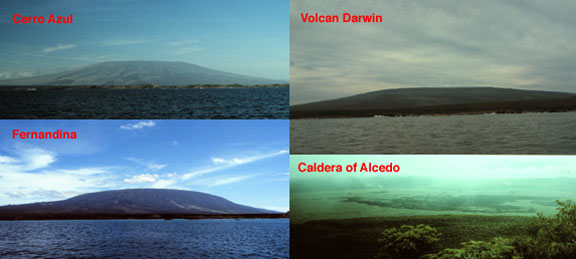|
Volcanism in the Galapagos Islands Basaltic Shield Volcanoes  | | A variety of shield volcanoes. Piture source: http://www.rit.edu/~rhrsbi/GalapagosPages/Vulcanism3.html |
Two distinct types of volcanoes occur in the Galapagos. The difference between these two volcanic morphologies appears to be due to the difference in lithosphere thickness. The fracture zone at 91° W separates oceanic crust and lithosphere of distinctly different age. West of the fracture zone at 91°W, the lithosphere is older and thicker, and therefore able to support the load imposed on it by a large volcano. East of the fracture zone, the lithosphere is too young and weak to support large volcanic edifices. The Hawaiian volcanoes, which are the largest on Earth and much larger than the largest of the Galapagos volcanoes, are located on very thick lithosphere.
In the west, on the islands of Isabela and Fernandina, the volcanoes are described as having an "inverted soup-bowl" morphology and deep calderas. The "inverted soup-bowl" morphology of the large western volcanoes is quite unusual (though not entirely unique) and its origin is not entirely certain. According to one theory, this morphology results from way in which eruptive vents are distributed on the volcanoes. Most of the vents occur either on circumferential fissures near the flat summits, or on radial fissures on the lower flanks and aprons of the volcanoes. Relatively few vents occur on the steep upper flanks of the volcanoes. Thus the volcano grows outward at the bottom and upward at the top, resulting in this distinctive morphology. The location of vents and fissures primarily reflects the stresses within the volcano. Why stresses in Galapagos volcanoes should differ from those of other volcanoes and lead to this distribution of vents remains unclear. An alternative hypothesis for the morphology of Galapagos volcanoes is that it reflects the pattern of intrusion of magma within the volcano. In essence, magma intruded into the volcano inflates the central part, pushing the summit region upward and steepening the slopes on the upper flanks.
|







